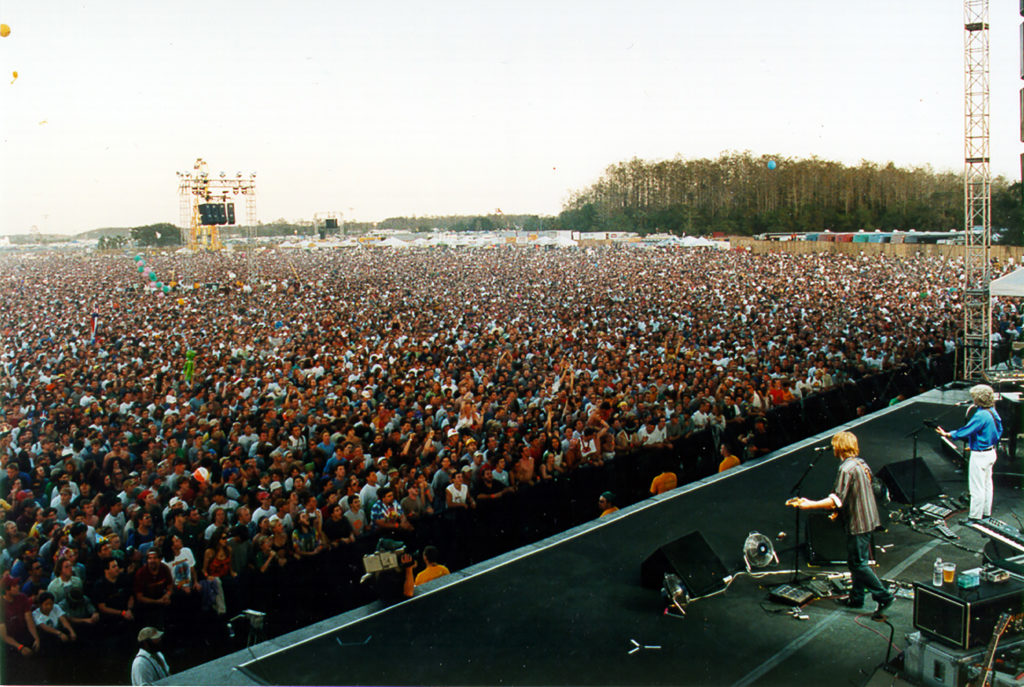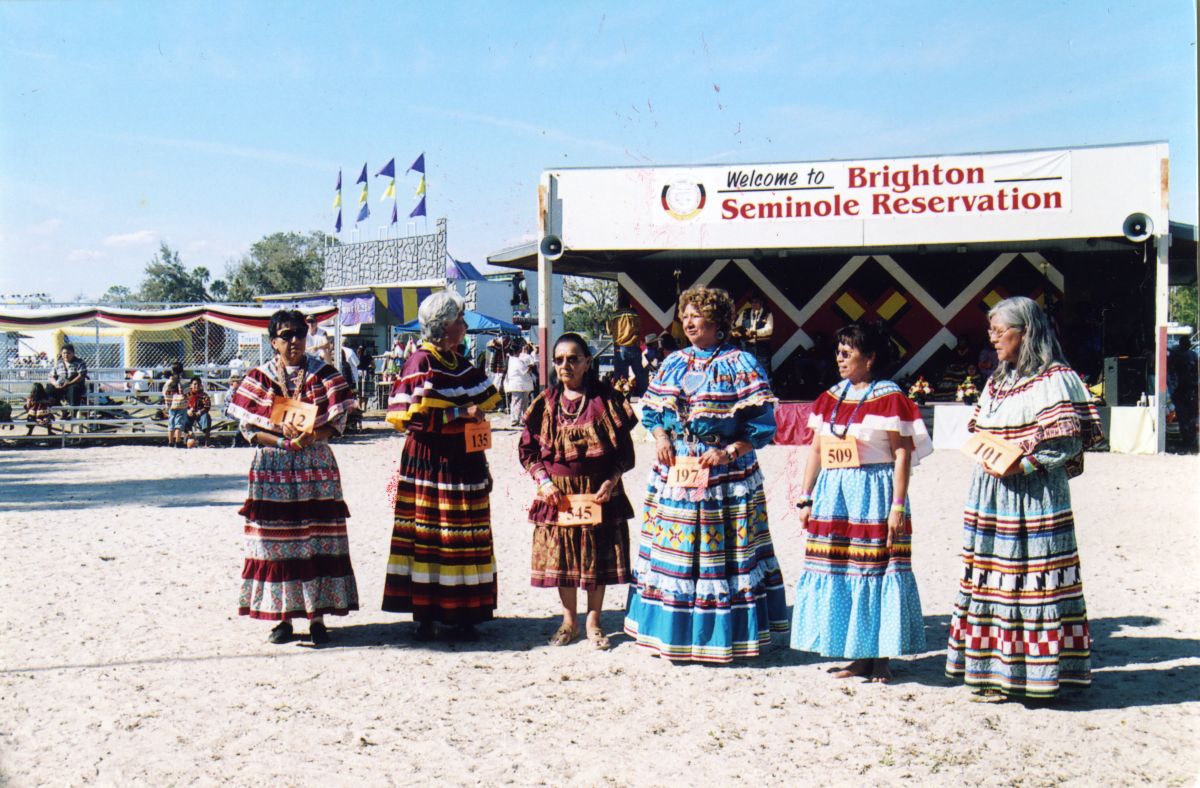
Seminole Tribe Rocks the 2000s
Welcome back to the latest installment in our Decades of Seminole Tourism series. Over the last year, we have traced the triumphs and struggles of Seminole tourism, economic independence, and survival since 1900. This week, join us for the triumphs of 2000s, as the Seminole Tribe rocks through Y2K.
In our featured image this week, the rock band Phish performs on the Big Cypress Seminole Indian Reservation. During the New Year’s 2000 concert, Phish performed to an estimated 80,000 screaming fans. The concert lasted well into the night. The triumph of the Phish concert would be a precursor to how the Seminole Tribe rocked this decade and expanded their gaming empire into the international sphere. The image is a Seminole Tribune file photo, via the Seminole Tribune.
Phish
To celebrate New Year’s 2000, the Seminole Tribe of Florida hosted the “largest concert on Earth to usher in the new millennium.” Held in John Motlow’s pasture, this seemingly innocuous event quickly blew up into one of the largest events ever seen in the Everglades. A 2020 Seminole Tribune article commemorating the 20th anniversary stated that an estimated 80,000 people attended the event. A two-day event, the final set lasted from the evening of December 31st, 1999, well into the morning of January 1st, 2000.
In 2019, Phish lead singer and founding member Trey Anastasio spoke about the show on After Midnight: Phish’s Big Cypress Festival, a five-part podcast hosted by Jesse Jarnow. “We played all night,” Anastasio said about the event. “We actually played two days, but the last set was from 11:15, or something, on New Year’s Eve, until 7 or 8 in the morning. It was incredible, and, for me, it was the greatest, the pinnacle.”
In the same podcast episode, it is noted that fans waited 18 hours in traffic. The news touted it as the “biggest traffic jam in the country.” Below, you can see a full-page ad from the Weekly Planet paper advertising the concert.. Tickets were limited to four per purchase, and included both events, parking, and camping for the weekend. In a December 17, 1999 Seminole Tribune article about the event, the tickets are listed as costing $175 each. The author of the article, Peter Gallagher, who was also appointed the Tribal Liaison for the concert by Chairman James E. Billie, wrote “It’s going to be awfully crowded in the cow pasture…the last time there was this much traffic in these parts, the U.S. Calvary was searching for Sam Jones and Billy Bowlegs.”

2003.269.12, ATTK Museum
Hard Rock Hollywood and Tampa
The success of the Phish concert was only the beginning of the Seminole Tribe’s triumphs over the decade. In the early 2000s, the Seminoles struck a deal for two Tribally- owned and operated Hard Rock Hotel and Casinos: one in Tampa, and one in Hollywood. The Tampa location opened first in March 2004. Seminole Hard Rock Hollywood opened soon after in May 2004. “The Hard Rocks [will] recontour Florida’s tourism market,” a Miami Herald article about the openings reads, “landing the Sunshine State on the lucrative casino-resort map, a spot long-craved by casino heavyweights” (10 May 2004, The Miami Herald). Jim Allen, Chairman of Hard Rock International and CEO of Seminole Gaming, stated that: “We could pick this thing up and put it in the middle of the Las Vegas strip or Atlantic City boardwalk and it could compete.”
But, while the glossy Seminole Hard Rock system now evokes an image of economic surety, at the time it was a risky move. In a 2014 Seminole Tribune article commemorating the 10-year anniversary of the first Seminole Hard Rock properties, Allen stated, “People gave us reason after reason why (Hard Rock Hollywood) would never work.” Allen has led Seminole gaming operations since 2001 and was instrumental in both the hotel and casino openings in 2004, as well as the Hard Rock International acquisition in 2007. At the anniversary event, former Chairman Mitchell Cypress, who was in office when the first deal for the two Seminole Hard Rock properties went through, was also honored. Former Chairman James E. Billie noted that: “People thought he was crazy to trust a bunch of white folk. It sure wasn’t so crazy now that we are all happy and fat.”
Seminoles Acquire Hard Rock International
Building off the Seminole Hard Rock of Hollywood and Tampa, the Seminole Tribe would go international only a few years later. In 2007, the Seminole Tribe of Florida purchased the Hard Rock International brand in a landmark $965 million-dollar deal. The purchase “marks the Tribe’s entry into the worldwide hospitality industry and gives the Tribe’s gaming operations a foothold in states where gambling is legal” (06 March 2007, Palm Beach Post). In the same article, then-Vice Chairman Moses Osceola stated: “The acquisition of the Rank-Hardrock system makes our economic survival a little bit more sure. We are bound and determined to make this thing work” (06 March 2007, Palm Beach Post). At the time, the Hard Rock system included 124 Hard Rock Cafes, five Hard Rock hotels, two Hard Rock Casino-Hotels, two Hard Rock Live concert venues, stakes in three unbranded hotels, and the famous 70,000-piece rock history memorabilia collection.
Below, you can see the Seminole Tribe of Florida holding a signing ceremony under the Council Oak in Hollywood, FL in March of 2007. The deal was one of the largest purchases every made by an American Indian tribe. On the Hard Rock International acquisition, then-Hollywood Council Representative Max B. Osceola emphasized that: “Now main street [in the business world] knows you can do business with native tribes and make a profit” (West 258). Osceola attended the federal recognition event at the Council Oak in 1957 as a child. From the hopeful signing of their Constitution in 1957, to the acquisition ceremony 50 years later, the Seminole Tribe of Florida continued to gamble on tourism as their method of survival, growth, and continued success.

(06 March 2007, Palm Beach Post)
What Makes the Seminole Hard Rock Venues Unique?
The Seminole Tribe worked hard to meld their identity with the established Hard Rock brand. At the Hard Rock Hollywood, which is right down the street from the Seminole Tribe Headquarters, the Council Oak Bar & Lounge commemorates the historic Council Oak tree. The Abiaka Wood Fire Grill features another nod to Seminole history. Abiaka, also known as Sam Jones, helped guide Seminoles through the nearly five decades of the Seminole War period. A “a medicine man, a warrior, a spy, a strategist, and a leader,” Abiaka and his followers never consented to removal from Florida. Those who survived would birth the Seminole Tribe of Florida that we know today. The Hard Rock Hollywood also hosts the Annual Seminole Tribal Fair and Pow Wow each year. Next year’s Tribal Fair will take place February 9-11, 2024 so mark your calendar!
Melding the culture of the Seminole Tribe with the international brand would only strengthen the Tribe’s economic position. The Seminole Tribe rocked the 2000s, setting them up for fiscal stability in a way that many had never even dreamed. Next time, join us to learn how the Seminole Tribe continued to expand their tribal tourism empire in the 2010s. Even with these whirlwind changes, the Seminole Tribe of Florida would stay true to their distinctive history and cultural identity.
Interested in the rest of our Decades of Seminole Tourism series? Check out previous blog posts on the 1900s, 1910s Part 1, 1910s Part 2, 1920s, 1930s, 1940s, 1950s, 1960s, 1970s, 1980s, and 1990s.
Additional Sources
The author accessed these sources digitally. Page reference numbers may not align with paper and hardback copies.
West, Patsy. The Enduring Seminoles: From Alligator Wresting to Casino Gaming, Revised and Expanded Edition. 2008. University Press of Florida. Digital.
Author Bio
Originally from Washington state, Deanna Butler received her BA in Archaeological Sciences from the University of Washington in 2014. Deanna moved to South Florida in 2016. Soon, she began working for the Seminole Tribe of Florida’s Tribal Historic Preservation Office. Deanna was the THPO’s Archaeological Collections Assistant from 2017-2021. While at the THPO, Deanna worked to preserve, support, and process the Tribe’s archaeological collection. She often wrote the popular Artifact of the Month series, and worked on many community and educational outreach programs. She lives in Fort Myers, FL with her husband, son, and dog.



